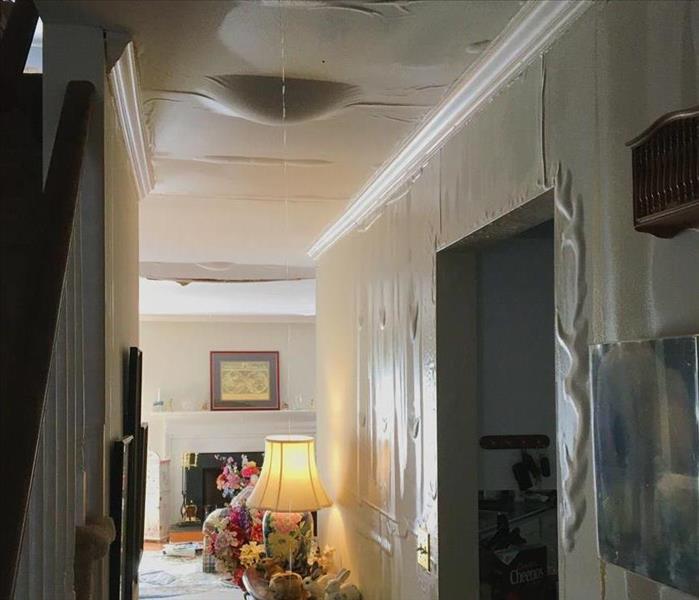What To Do When Ice Dams Leak In Your House
1/5/2021 (Permalink)
 An ice dam on the roof of this Madison, NJ home caused a serious ceiling leak which required extensive water damage restoration.
An ice dam on the roof of this Madison, NJ home caused a serious ceiling leak which required extensive water damage restoration.
Your home may be extra cozy after a big snowstorm, but it's also extra likely for ice dams to form on your roof after a heavy snow. The leaks that result from ice dams can cause extensive water damage and mold growth throughout your Madison, NJ home. Here, we will review how to deal with roof or ceiling leaks from ice dams.
Why Do Ice Dams Form?
Ice dams essentially form because of higher than freezing temperatures in your attic. When temperatures are above freezing, it causes your roof to warm up. This melts the snow and ice on your roof, which then drips down and refreezes at your roof eaves. The continually melting snow causes the ice dam on your roof to grow larger and larger over time.
How Do Ice Dams Leak Into Your House?
Over time, an ice dam causes melted snow water to backup underneath your roof shingles. Once water penetrates the waterproof protective barrier on the sheathing of your roof, you'll be dealing with a roof leak from an ice dam.
Once water flows into the attic of your home, you'll begin to see signs of water damage from the roof leak.
Signs of water damage from an ice dam include:
- Wet insulation in the attic
- Visible water leaks
- Water stains on ceilings in living spaces
- Bubbling paint
- Mold growth in attic or on ceilings
- Buckling or bending walls, floors, or ceilings
What To Do When Ice Dams Leak Into Your Home
When you identify an ice dam on your roof, you want to act fast to prevent further damages to your home. Water damage can cause serious structural deterioration to your home, and the ice dam can damage your roof or come crashing down at a moment's notice. Take these steps when you notice roof or ceiling leaks from ice dams:
1. Call a professional for ice dam removal in New Jersey
We always recommend calling in a professional ice dam removal company to get rid of these damaging blocks of ice on your roof. Climbing onto your snowy roof is a major safety hazard, and DIY ice dam removal tips can end up causing more damage to your roof when you use a hammer or calcium chloride to melt it off. Professional ice dam removal companies use steam machines, which effectively and safely melt ice dams from your roof.
- This step helps stop the leaks in your roof until you have a company come out to complete needed repairs.
2. Call your insurance company
Your homeowners insurance policy should cover the damages caused by your ice dam, but will not cover ice dam removal. You'll want to file a claim so that you're not stuck paying thousands of dollars for needed water damage restoration and roof repairs. The companies that come out to fix damages can be paid by your insurance company directly.
3. Call a water damage restoration service in New Jersey
You'll need a water damage restoration company like SERVPRO of Morristown to clean up the damage due to attic or ceilings leaks from an ice dam. SERVPRO of Morristown can address all wet drywall, wet ceilings, wet carpets, water stains, or mold caused by ice dams leaking into your home.
When you call SERVPRO of Morristown we:
- Take detailed information on the cause of your water damage
- Send out a Project Manager to inspect all damages and create a drying & restoration plan
- Provide emergency water removal services
- Set up all needed drying equipment, such as air mover, dehumidifiers, or floor mats
- Perform demolition of wet areas as needed to ensure proper drying
- Perform mold remediation as needed
- In-house construction team ensures your home is brought back to pre-damage conditions
4. Take steps to prevent ice dams in the future
To prevent roof or ceiling leaks from ice dams from happening again, you can take the following steps:
- Remove snow with a roof rake after heavy snow
- Properly insulate your attic from the living space so that it stays cool
- Make sure your attic has proper ventilation to keep the roof cool
- Clean your gutters so that melting snow easily drains away from the roof
Ice Dams Leaking Into Your Home in New Jersey? Call SERVPRO For Immediate Assistance - 800-734-3213
Related Articles:
Preparing For A Blizzard This Winter



 24/7 Emergency Service
24/7 Emergency Service